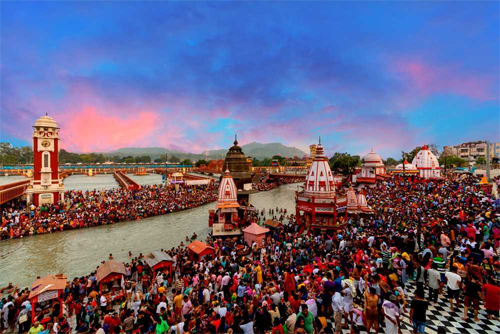Haridwar City
 Haridwar means "Gateway to God", "Hari" means God and "Dwar" means gateway. Around 205 km from Delhi, and just 26 km from Rishikesh, Haridwar stands at the place where the river Ganga emerges from the Shivalik range of hills. It is an ancient town which has found mention in the memoirs of the Chinese traveler th Husan Tsang who visited India in the 7 Century. In its early days, the town was also known Mayapuri. Haridwar is essentially a Hindu Pilgrim town with temples, hermitages and dharmshalas along the banks of the Ganga. There are numerous legends associated with its founding which are as colorful as the mythology that infuses the Hindu religion. Haridwar is said to have been sanctified by the three deities of the Hindu Pantheon- Brahma, Vishnu and Mahesh (Shiva). If Haridwar has footprint, on stone it is said to be that of Lord Vishnu.
Haridwar means "Gateway to God", "Hari" means God and "Dwar" means gateway. Around 205 km from Delhi, and just 26 km from Rishikesh, Haridwar stands at the place where the river Ganga emerges from the Shivalik range of hills. It is an ancient town which has found mention in the memoirs of the Chinese traveler th Husan Tsang who visited India in the 7 Century. In its early days, the town was also known Mayapuri. Haridwar is essentially a Hindu Pilgrim town with temples, hermitages and dharmshalas along the banks of the Ganga. There are numerous legends associated with its founding which are as colorful as the mythology that infuses the Hindu religion. Haridwar is said to have been sanctified by the three deities of the Hindu Pantheon- Brahma, Vishnu and Mahesh (Shiva). If Haridwar has footprint, on stone it is said to be that of Lord Vishnu.
Every twelve years Haridwar plays host to thousands of pilgrims from all over the country who come to participate in the Poorna Kumbha Mela, a great religious gathering where the large congregation listens to spiritual discourses from sanyasis and sages, and take a dip in the Ganga on the first day of Baisakhi (April 13. In between, every 6 years, there is also the Ardhakumbh Mela at the same place.
Temples, bathing ghats, and hermitages are the main places of interest in this temple town. In the evenings, the aarti (the ritual of worship) at Har-Ki-Pauri is an elevating experience. A stroll along the bank of the Ganga is enjoyable. People light Diyas (earthen lamps) and float them on the river, each Diya carrying a fond wish. The twinking earthen lamps make a beautiful sight in that ambience of temple bells and religious music that wafts through the air around the ghats. Bhimgoda Tank, Parmarth Ashram, Sapt Sarovar, Daksh Mahadev Temple, Sati khund, Chandi Devi Temple, Mansa Devi Temple, Chilla Wild Life Sanctuary, Pawan Dham, Bharat Mata Mandir and Doodhadari are also places worth a visit.